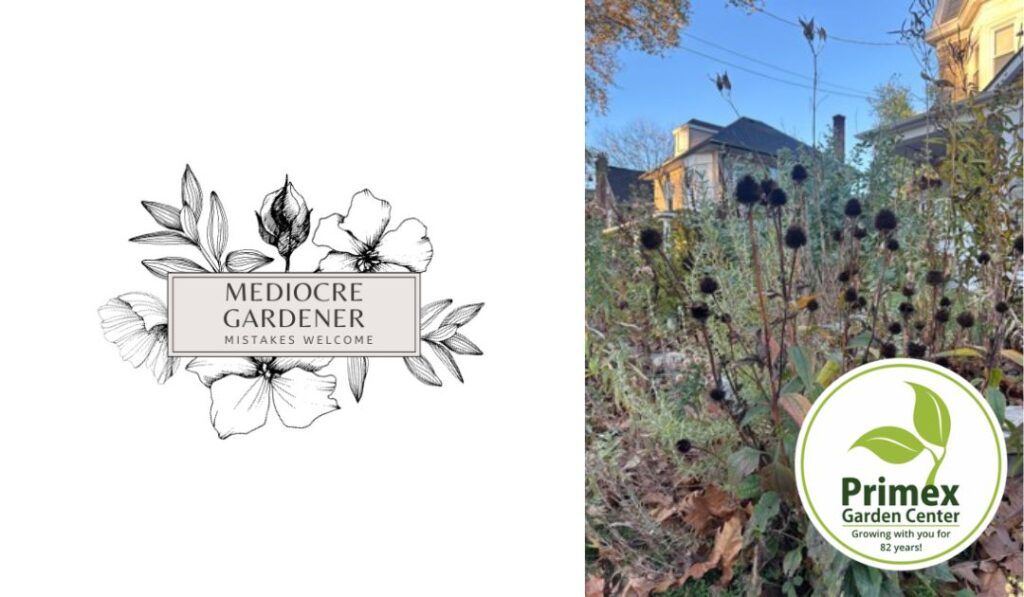Happy November garden friends! It’s time to start thinking about winding down the garden for the season, but not in the way you might think. While it’s tempting to go full Marie Kondo on your beds, clearing every leaf and chopping every stem, I’m here to make the case for a messier, more nature-friendly approach.
But, before we get started, I’ve a favor to ask. If you check out my Instagram page here, I’ve been posting pictures and videos of my Mediocre Garden. Things like my dahlias growing sideways, the weeds sprouting in containers that the bunnies just love and fennel that’s popping up everywhere but being enjoyed by the caterpillars. I would love to hear about your “Mediocre Gardener Moments.” What’s going wrong in your space but maybe making a beautiful habitat for bees? What did you plant in your garden that hasn’t taken off or has overtaken your space? I’d love to know how your garden grew this season. You can contact me on Instagram or email me at dearmediocregardener@gmail.com. I can’t wait to hear your stories and hopefully feature some in future columns!

Composting: Giving Back to the Soil
Right, back to the garden So, your green space has given you tomatoes, peppers, flowers, and more all season long, now it’s time to give something back. Composting is the perfect way to recycle garden waste into nutrient-rich soil for next year.
What to compost:
Spent veggie plants (but remove any diseased ones)
Fallen leaves (great for balancing nitrogen-heavy kitchen scraps)
Grass clippings (mix them with dry leaves to prevent a slimy mess)
Wilted flowers & soft stems (they’ll break down beautifully)
What not to compost:
Weeds with seeds (unless you want a surprise crop of them next year)
Invasive plants (like bindweed or thistle)
Anything treated with pesticides (we want happy, healthy microbes!)
Leave the Leaves: Your Garden’s Winter Blanket
I get it, piles of leaves might look untidy, but they’re one of the best things you can leave in your garden. Why? Because so many beneficial critters rely on them for survival:
Fireflies? They start their life cycle in the leaf litter.
Butterflies and moths? Many species overwinter as caterpillars or pupae tucked beneath the leaves.
Bees? Some of our native solitary bees hibernate in stems and leaf piles.
Small mammals? They use the leaves for warmth and shelter.
So instead of bagging them up and sending them away, rake them into garden beds, around tree bases, or into designated “wild corners” of your yard. Your soil will thank you in the spring, and so will the pollinators.
Save Those Stems: Bee Hotels in the Making
Another common fall task is cutting back all the spent stems from perennials but hold those pruners! Many native bees and other beneficial insects lay their eggs in hollow stems, using them as nurseries for the next generation.
What to do instead:
Leave stems standing at least 12-18 inches for bees to nest in over winter.
If you must cut them back, bundle stems loosely and set them in a quiet corner of your yard for insects to use.
Wait until late spring to remove stems, once temps are consistently above 50°F, to give overwintering insects a chance to emerge.
Other Garden Cleanup Tips (Without Overdoing It!)
Mulch your beds with chopped leaves or straw to insulate plants and protect soil microbes.
Harvest the last of your herbs and dry them for winter teas and seasonings.
Save seeds from your favorite flowers and veggies to plant next year.
Leave some dead plant material for birds, they’ll appreciate the extra food and shelter.
Final Thoughts: Embracing the “Messy” Garden
November garden cleanup doesn’t have to mean wiping the slate clean. By letting nature take its course, keeping leaves, stems, and seed heads around, you’re actually creating a healthier, more resilient garden for next year. Plus, you’re supporting an entire ecosystem of beneficial insects and wildlife. Happy (light) tidying!
For more of The Mediocre Gardener’s column with Glenside Local, you can click here. For more on Primex Garden Center of Glenside, you can visit their website and Facebook page.
For all the latest news, follow us on Facebook or sign up for Glenside Local’s “Daily Buzz” newsletter here.


Comments are closed.